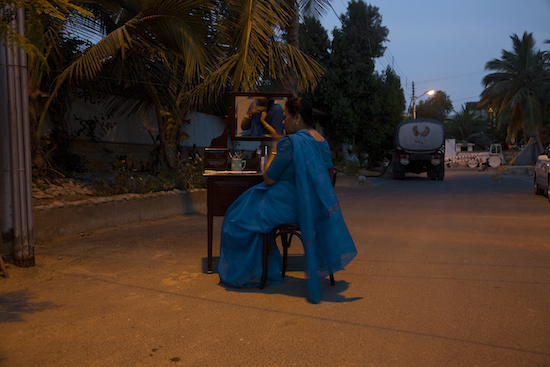Destilaciones
2014 - Sculpture (Sculpture)
Ximena Garrido Lecca
Destilaciones ( Distillations , 2014) is an installation composed of a group of ceramic pots, presented on the floor and within a steel structure. Copper pipes run through the perforated ceramics, evoking the design of an oil purifier. The work is a direct reference to the history of the Peruvian coastal town of Lobitos. The extraction of oil began in Lobitos at the start of the twentieth century, with the arrival of the British oil company Lobitos Oilfields Limited. The infrastructure built alongside the plant included a desalination plant (now defunct), a church, a casino, and a cinema (one of the first in Latin America), all now in ruins. Following a 1968 military coup, the Peruvian government initiated a program of nationalization and the oil fields fell under the control of the state. The Ministry of Defence built a military base on the adjacent land. Soon, a slow decline due to mismanagement sent the town into economic collapse, mirroring the economy nationally. Today one encounters the ruins of buildings left by the British oil company; the debris of what used to be the old military base; and the traffic of surfers that come every year in search of waves. Currently, the oil extraction is concessioned to South American Petroleum Exploration Tech (Sapet), a transnational company funded mainly with Chinese capital. There is also a major investment plan to privatize the town, proposing a transformation of Lobitos into a tourist resort. Destilaciones portrays these different waves of colonialism and the exercise of authoritarian power within the context of a developing country. By tracing economic and political cycles, the artist intends to register the residue of human activity within the landscape. Environmental and social issues are presented in relation to the modern exploitation of resources and localized ancient practices such as fishing and pottery. The three epochs of political domination that have left their mark on Lobitos—European colonialism, the nation-state autonomy, and neoliberal globalization—have all left behind remnants of their failure.
Ximena Garrido-Lecca examines the turbulent history of Peru, and specifically how neocolonial standards are transmitted through the processes of globalization. The artist approaches her works by scrutinizing urban, rural, and vernacular architecture, concentrating on spaces where a mediatory materiality is visible between the specific and the universal. Equally important is the memory of artisanal tradition and the abandonment of rural spaces as an aftereffect of the processes of modernization. Her work insinuates a permanent tension between the inheritance of vernacular culture and the new demands of industrialization, signaling the violence contained in an accelerated transnational economic model in increasingly open confrontation with the protection of the environment, sovereignty, and respect for different community lifestyles.
Colors:
Related works featuring themes of: » Andes Region, » Architecture in Art, » Collective History, » Cross-Cultural Dialogue, » Peruvian
» see more

© » KADIST
Bani Abidi
2008The threshold in contemporary Pakistan between the security of private life and the increasingly violent and unpredictable public sphere is represented in Abidi’s 2009 series Karachi ...

© » KADIST
Bani Abidi
2012The perceived effortlessness of power, projecting above experiences of labored subordination is examined in Death at a 30 Degree Angle by Bani Abidi, which funnels this projection of image through the studio of Ram Sutar, renowned in India for his monumental statues of political figures, generally from the post-independence generation...

© » KADIST
Claudia Joskowicz
2007The primary interest in the trilogy is Joskowicz’s use of cinematic space, with long tracking shots that portray resistance to habitual viewing experiences of film and television...
Other related works, blended automatically
» see more

© » KADIST
Bani Abidi
2008The threshold in contemporary Pakistan between the security of private life and the increasingly violent and unpredictable public sphere is represented in Abidi’s 2009 series Karachi ...

© » KADIST
Bani Abidi
2012The perceived effortlessness of power, projecting above experiences of labored subordination is examined in Death at a 30 Degree Angle by Bani Abidi, which funnels this projection of image through the studio of Ram Sutar, renowned in India for his monumental statues of political figures, generally from the post-independence generation...

© » KADIST
Oscar Munoz
2009In Ante la imagen (Before the Image, 2009) Muñoz continues to explore the power of a photograph to live up to the memory of a specific person...

© » KADIST
Joachim Koester
2006Physical and mental exploration have been founding elements in Joachim Koester’s research for several years...
Related works sharing similar palette
» see more

© » ARTFORUM
New York’s Rubin Museum to Shutter, Pursue Decentralized Model – Artforum Read Next: ITALIAN CULTURE MINISTER VITTORIO SGARBI EXITS UNDER PRESSURE Subscribe Search Icon Search Icon Search for: Search Icon Search for: Follow Us facebook twitter instagram youtube Alerts & Newsletters Email address to subscribe to newsletter...

© » KADIST
Ishola Akpo
2021Noticing the lack of archives on the queens of various African kingdoms, artist Ishola Akpo created several series of work that retrace their history...
Related works from the » 2010's created around » London, United Kingdom
» see more

© » KADIST
Wolfgang Tillmans
2017Wolfgang Tillmans initiated the ongoing series Faltenwurf in 1989, representing compositions of unused clothing, with special attention paid to the ways in which they drape and fold...

© » KADIST
Matt Mullican
2018Mullican’s Stick Figure Drawings depict characters reduced to their most basic graphic representation...

© » KADIST
Tomoko Yoneda
2010Yoneda’s Japanese House (2010) series of photographs depicts buildings constructed in Taiwan during the period of Japanese occupation, between 1895 and 1945...
Related artist(s) to: Ximena Garrido Lecca » Pedro Reyes
» see more

© » KADIST
Pedro Reyes
2012Pedro Reyes’s Los Mutantes ( Mutants , 2012) is composed of 170 plates that combine characters from ancient and modern mythologies...

© » KADIST
Pedro Reyes
2005In Reyes’s words, “We should be able to extract the technological nutrients before we excrete our waste...
Related works found in the same semantic group
» see more

© » KADIST
Yuichiro Tamura
2017The installation Hey Daddy, Hey Brother comprises a series of “Sukajan” jackets, which Tamura collected over a period of several years...

© » KADIST
Geof Oppenheimer
2011Designed as an installation timed spent is determined by the viewer, as with classical sculpture, Anthems is a piece that is in place, and in time, and an important genre of video within the collection...

© » KADIST
Maya Watanabe
2021Maya Watanabe’s video installation Bullet unfolds within the context of the Peruvian justice and forensic systems...







